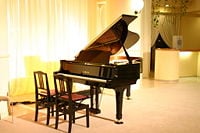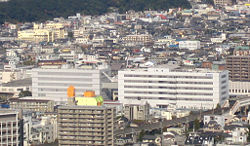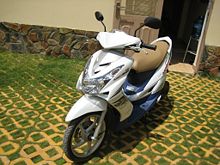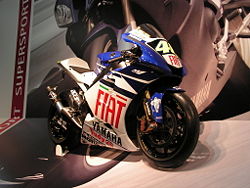Yamaha Corporation
| Yamaha Corporation Kurosawa | |
| Type | |
|---|---|
| Founded | October 12, 1887 |
| Headquarters | Hamamatsu, Shizuoka prefecture, Japan |
| Industry | Conglomerate |
| Products | Musical instruments, Audio/Video, Electronics, Computer related products, ATVs, Motorbikes, Vehicle Engines, Personal water craft |
| Revenue | |
| Operating income | 900 million US$ (2005) |
| Net income | 149 million US$ (2003) |
| Employees | 23,500 (3/2003)
|
| Website | www.global.yamaha.com/
|
The Yamaha Corporation (ヤマハ株式会社,Yamaha Kabushiki Gaisha) (TYO: 7951) is one of the most diversified companies in Japan, offering a wide range of products and services, predominantly musical instruments and electronics. Originally founded to manufacture reed organs in 1887, as Yamaha Organ Manufacturing Company, the company was incorporated in 1897, as Nippon Gakki Company, Limited (日本楽器製造株式会社, Nippon Gakki Seizō Kabushiki Gaisha, “Japan Musical Instruments”) and quickly entered into the production of upright pianos. Taking advantage of every opportunity to use its existing technology and expertise to expand into new markets, Yamaha began producing harmonicas during World War I and hand-wound phonographs in the 1920s. During the 1950s and 1960s, with experience gained during World War II, Yamaha began the manufacture of boats, bows for archery, and other products made from fiberglass reinforced plastics (FRP). In 1955, Yamaha Motor Corporation began the production of motorcycles, and in 1968, released an off-road bike, the Yamaha DT-1, creating a new genre known today as trail bikes.
Starting in the 1970s, Yamaha developed a wide range of electronic musical instruments and technologies. Today it is the largest manufacturer of musical instruments in the world, and Yamaha Motor Corporation is the second-largest manufacturer of motorcycles. Yamaha strives to give its customers an experience of excitement and pleasure by “exceed[ing] their every expectation.” It pays close attention to the needs and desires of its customers during product development and provides excellent after-sale service. Yamaha sponsors musical groups and events, contests, motor sports competitions, and programs such as the Yamaha music schools that help cultivate a future market for musical instruments; and provides opportunities such as sports and music resorts for customers to fully enjoy its products.
History
Early years
Yamaha Corporation is named for its founder, Torakusu Yamaha (山葉 寅楠, Yamaha Torakusu; April 20, 1851–August 8, 1916). His father, a samurai from Wakayama Prefecture, was interested in astronomy and mechanics and gave his son a modern education. Yamaha studied watch repair under a British engineer, then completed an apprenticeship at Japan's first school of Western medicine in Nagasaki and took a job repairing medical equipment in the isolated town of Hamamatsu. When a local school requested that he repair their prized U.S.-made Mason & Hamlin reed organ, he realized the business potential of manufacturing organs in Japan, and in 1887, he founded Yamaha Organ Manufacturing Company, the first manufacturer of Western musical instruments in Japan, and built his first portable reed organ. By 1889, the company employed 100 people and produced 250 organs annually.[1]
Yamaha observed that less-expensive upright pianos were becoming more popular than organs in U.S. homes and decided to manufacture them in Japan. On October 12, 1897, he incorporated his company as Nippon Gakki Company, Limited (日本楽器製造株式会社, Nippon Gakki Seizō Kabushiki Gaisha, “Japan Musical Instruments”) in Hamamatsu, Shizuoka prefecture. The same year, Yamaha fulfilled its first export order of 78 organs to Southeast Asia.[2]
In 1899, the Japanese Ministry of Education sent Yamaha to the United States to study piano making and to establish suppliers for the materials needed to produce pianos in Japan. Nippon Gakki began making upright pianos in 1900 and produced its first grand piano in 1902, applying its expertise in woodworking to the manufacture of fine furniture. At the St. Louis World’s Fair in 1904, a Yamaha piano and organ received the Honorary Grand Prize. In 1914, when World War I curtailed the sale of German harmonicas in Japan, Yamaha introduced its first harmonica and began exporting harmonicas worldwide. Yamaha continued to expand into the music field, launching high-quality hand-wound phonographs in 1922.
Faced with competition from Western-made instruments, Nippon Gakki opened the world’s first acoustic research laboratory in 1930. In 1931, it engineered the acoustics of Japan’s new Diet halls. In 1932, it began the production of pipe organs. During the 1930s, the expansion of the public school system in Japan created a demand for Western musical instruments, and Nippon Gakki began to produce competitively-priced accordions and guitars. It produced its first acoustic guitar in 1942.
After World War II
During World War II, Nippon Gakki produced propellers for Zero fighter planes, fuel tanks, and wing parts, and eventually stopped producing musical instruments altogether. The new technologies learned during war manufacturing enabled Nippon Gakki to cast its own metal piano frames. In 1948, its music business suddenly increased when the Japanese Ministry of Education mandated music education in the public schools. By the 1950s, Yamaha was the world’s largest manufacturer of pianos. It also began to produce audio components, and in 1955, it produced its first high-fidelity (Hi-Fi) record player.[3]
One of Nippon Gakki’s chief principles was to expand its business by finding new uses for its existing technologies and materials. After World War II, the fourth president of Yamaha, Gen-ichi Kawakami (川上源一, Kawakami Gen'ichi, January 30, 1912–May 25, 2002), looking for new ways to utilize the company’s manufacturing facilities, began to seriously investigate overseas markets. He visited the United States several times, considering the production of sewing machines, auto parts, scooters, three-wheeled utility vehicles, or motorcycles. Since financing for new factories was scarce, Nippon Gakki began to research new uses for materials such as fiberglass reinforced plastics (FRP). In 1960, the company produced its first FRP sailboat, and later manufactured yachts, patrol boats for Japan's Maritime Safety Agency, and oceangoing fishing vessels. Other FRP products, such as bows for archery, skis, and bathtubs soon followed. Research to develop metal alloys led to the production of equipment such as boilers and central heating systems for the construction industry.[4]
Electronics
In the 1970s, integrated circuits (ICs) replaced transistors, and because it was unable to find a suitable manufacturer, Nippon Gakki built its own factory to manufacture them in 1971. This allowed Nippon Gakki to meet the rapidly increasing demand for electronic keyboards and audio components. In 1976, it opened a plant to produce large-scale integrated circuits (LSIs) and converted all of its electronic products, such as keyboards, from analog to digital formats. Nippon Gakki used LSIs to produce its first professional sound systems and to manufacture new products for the consumer audio industry during the early 1980s. The DX-7 digital synthesizer, introduced in 1983, became the world’s best-selling synthesizer. The same year, the company began to sell its LSIs to other manufacturers.
Yamaha Motor Company Limited
The company's intensive research into metal alloys for use in acoustic pianos had given Yamaha wide knowledge of the making of lightweight, yet sturdy and reliable metal constructions. This knowledge was easily applied to the making of metal frames and motor parts for motorcycles. Kawakami and his engineers toured German factories to learn how to make motorcycles. Their motto was, "If you are going to make it, make it the very best there is." The first prototype, the Yamaha YA-1, named in honor of Yamaha’s founder, was completed in August 1954. The bike was powered by an air-cooled, 2-stroke, single cylinder 125 cc engine. The prototype was put through an unprecedented 10,000 km endurance test to ensure that its quality was top-class.
In its first year of production (1954), Yamaha built 125 YA-1 (also called Akatombo, the "Red Dragonfly") motor bikes. The YA-1 was patterned after the German DKW RT125 (which had also been copied by the British munitions firm, Birmingham Small Arms Company, as the BSA Bantam, and by Harley-Davidson as the Hummer).
The success of the YA-1 resulted in the founding of the Yamaha Motor Co., Ltd. on July 1, 1955. The new motorcycle manufacturer produced about 200 units per month. The same year, the YA-1 won the 125cc class in the two biggest race events in Japan, the 3rd Mt. Fuji Ascent Race and the 1st Asama Highlands Race. The following year, the YA-1 won again in both the Light and Ultra-light classes of the Asama Highlands Race.
By 1956, a 175cc single cylinder two-stroke model, the YC1, was ready for production. In 1957, Yamaha began production of its first 250 cc, two-stroke twin, the YD1. In 1958, Yamaha became the first Japanese motorcycle manufacture to enter the international race arena, and won an impressive 6th place in the Catalina Grand Prix race in the United States. Yamaha acted quickly on this celebrity and began marketing its motorcycles through an independent distributor, Cooper Motors, in California in 1958.
In 1963, Yamaha developed the Autolube System, a separate oil injection system for two-stroke motor cycle engines, eliminating the inconvenience of pre-mixing fuel and oil. In 1966, Toyota and Yamaha teamed up to produce the limited edition Toyota 2000 GT sports car, still admired for its performance and craftsmanship.[5] In 1968, Yamaha launched the Yamaha DT-1, the world's first true off-road motorcycle, creating a new genre known today as trail bikes. Yamaha has since made an extensive number of two- and four-stroke scooters, on-road and off-road motorcycles. The Yamaha XS 650, introduced in 1970, was such an overwhelming success that it ended the British monopoly of vertical twin motorcycles. Today, Yamaha Motor Company is the world's second largest producer of motorcycles (after Honda).[6] It also produces all-terrain vehicles (ATVs), boats, snowmobiles, outboard motors, and personal watercraft. In 2000, Toyota and Yamaha formed an alliance in which Toyota paid Yamaha Corporation 10.5 billion yen for a 5 per cent share in Yamaha Motor Company while Yamaha and Yamaha Motor each bought 500,000 shares of Toyota stock.
Yamaha Corporation of America
In 1960, the Yamaha Corporation of America (YCA), then Yamaha International Corporation, was established to market a full line of musical instruments and audio/visual products in the United States. YCA is a wholly-owned subsidiary of Yamaha Corporation, Japan, and is the largest of all global subsidiary companies. A subsidiary of YCA, Yamaha Commercial Audio Systems (YCAS), established in 2006, offers a growing line of commercial audio products for the U.S. and Canadian markets, and distributes Nexo speaker products.
Another subsidiary of YCA, Yamaha Electronics Corporation (YEC), offers a comprehensive line of audio and video products in the U.S. home entertainment market.
The Yamaha Corporation
In October 1987, on its 100th anniversary, Yamaha changed its official name to The Yamaha Corporation.
In 1989, Yamaha shipped the world's first CD recorder. In 1988, Yamaha purchased Sequential Circuits and from 1989–1993, bought a significant share (51 percent) of competitor Korg. It also acquired German Audio Software manufacturers Steinberg in 2004, from Pinnacle.
Following a period of financial difficulty during the 1980s, the eighth president, Seisuke Ueshima, began to reorganize the company in 1992. For markets that were already almost saturated, Yamaha focused on high-end products, such as the Disklavier series of pianos, with built-in computers for recording and playing back performances, which could retail for more than $30,000 and bring in higher profits. Ueshima pushed the company to develop new products. In 1993, Yamaha successfully launched the Silent Piano series, pianos that could either be played as regular acoustic pianos, or with their sound muted and only audible to the pianist through headphones. This was followed by a Silent Trumpet in 1995, Silent Drums in 1996, the Silent Violin in 1997, and the Silent Cello in 1998. The VL1 and VP1 virtual acoustic synthesizers, instead of storing libraries of sounds to be replayed, used computer models of the instruments themselves to producer a wider variety of more authentic sounds.
In 2002, Yamaha closed down the archery product business, which it had started in 1959. Six archers in five different Olympic Games won gold medals using Yamaha products.[7]
In July 2007, Yamaha bought out the minority shareholding of the Kemble family in Yamaha-Kemble Music (UK) Ltd, Yamaha's UK import and musical instrument and professional audio equipment sales arm, and renamed the company Yamaha Music U.K. Ltd..[8] Kemble & Co. Ltd, the UK piano sales and manufacturing arm, was unaffected.[9]
On December 20, 2007, Yamaha made an agreement with the Austrian Bank BAWAG P.S.K. Group BAWAG to purchase all the shares of Bösendorfer,[10] intended to take place in early 2008. Yamaha intends to continue manufacturing at the Bösendorfer facilities in Austria.[11] Yamaha's acquisition of Bösendorfer was announced after the NAMM Show in Los Angeles, in January, 2008. On February 1, 2008, Bösendorfer Klavierfabrik GmbH began to operate as a subsidiary of Yamaha Corporation.[12] Yamaha has become the world's largest manufacturer of musical instruments (including "silent" pianos, drums, guitars, violins, violas and celli), as well as a leading manufacturer of semiconductors, audio/visual, computer related products, sporting goods, home appliances and furniture, specialty metals, machine tools, and industrial robots. Yamaha owns numerous subsidiaries and affiliates in overseas markets in addition to a number of related companies in Japan.
Yamaha owns and operates several unique resort facilities in Japan that provide its customers with the opportunity to enjoy leisure and cultural activities involving Yamaha products, including golf, motor sports and music.
Other companies in the Yamaha group include:
- Yamaha Motor Company
- Yamaha Fine Technologies Co., Ltd.
- Yamaha Livingtec Corporation
- Yamaha Metanix Corporation
- Yamaha Pro Audio
Corporate philosophy
Yamaha Corporation was an outgrowth of Meiji Japan's enthusiasm for new technologies, and of the ability of its young, educated middle-class entrepreneurs to develop new products based on Western imports. Throughout its development, the company has been characterized by a long-range perspective and an emphasis on research and development. One of Yamaha’s core principles has been to develop new products and enter new markets using its existing expertise and technologies. Today it is one of the most diversified companies in Japan.[13]
Yamaha’s stated corporate objective is “to contribute to the enrichment of the quality of lives for people around the world.” It strives to give its customers an experience of excitement and pleasure by exceeding “their every expectation, by using both leading-edge and traditional technology to supply products and services built on a foundation of sensitivity and creativity.”[14] Yamaha accomplishes this by paying close attention to the needs and desires of its customers and providing excellent after-sale service. Its forward-looking vision is demonstrated in programs such as the Yamaha music schools that cultivate a future market for musical instruments. Yamaha also provides opportunities for customers to fully enjoy its products by sponsoring musical groups and events, contests, motor sports competitions, and resorts offering leisure activities such as golf, sailing, and motorcycling.
Logo
The company's logo, a trio of interlocking tuning forks enclosed in a circle, reflects the company’s origins as a musical instrument manufacturer.[15] The Yamaha logo incorporating the three tuning forks was adopted in 1967. Used in various forms over the years, the current Yamaha logo was standardized in 1998.
The three tuning forks are said to represent “the cooperative relationship that links the three pillars of [Yamaha’s] business—technology, production, and sales,” and “the three essential musical elements: melody, harmony, and rhythm.” The tuning forks also “evoke the robust vitality that has forged a reputation for sound and music the world over, a territory indicated by the enclosing circle.”[16]
Music

Yamaha’s commitment to supporting music education and promoting the enjoyment of music distinguishes it from its competitors. Yamaha Music Foundation, established in 1966, has initiated a wide range of music programs around the world, including the Junior Original Concert. During a temporary retirement that began in 1976, Gen-ichi Kawakami wrote several books on music and, during the 1980s, founded the largest system of community music schools in the world, operating in Japan and 40 other countries. These schools promote musical education at an early age and help to ensure a future market for Yamaha products.
Nearly three-fourths of Yamaha Corporation's net sales are derived from its musical instrument and audio products operations.[17] Yamaha’s Music Marketing Group (MMG) sells and markets piano and keyboard products, band and orchestral instruments, live sound and music production products, guitars, drums, and consumer products. Yamaha also provides customer support for professional musicians at three US-based facilities: Yamaha Artist Services, Inc. (YASI) in New York City, Yamaha Corporate Artist Affairs (YCAA) in Franklin, TN, and Yamaha Artist Services Hollywood (YASH) in North Hollywood, CA.[18]
Yamaha guitars
Yamaha produced its first acoustic guitar in 1942, its first solid body guitar in 1965, and its first bass guitar in 1966. By the early 1970's, the quality and design of Yamaha guitars had been recognized by artists such as Carlos Santana and Bob Marley. The "Broad Bass," introduced in 1977, quickly caught international attention. In the 1980s, Yamaha opened a guitar factory in North Hollywood, California, which collaborated with professional guitar players in its product development.
Yamaha acoustic guitars are known for their sustained and powerful warm tone. Yamaha’s goal is that every guitar must have a balanced tone and response, and the bass and treble must complement each other so that the guitarist does not have to compensate. An all-wood dovetail neck joint, introduced in the 1970s, heightens the flow of resonance from the neck to the body of the guitar, and a blend of quality woods is used to optimize sound texture. Yamaha has worked closely with lacquer manufacturers to develop a finish that allows the guitar to “breathe.”[19] Well-known musicians who have played Yamaha guitars over the years include Michael Anthony, John Denver, John Lennon, Bob Marley, Brian May, Paul McCartney, Jimmy Page, Carlos Santana, Bob Seger, Billy Sheehan, Paul Simon, Bruce Springsteen, and James Taylor.[20]
Racing heritage
Yamaha has a long racing heritage. Its machines and its teams have won many competitions in a variety of classes of motorcycle racing and off-road racing. Riders such as Bob Hannah, Heikki Mikkola, Kenny Roberts, Chad Reed, Jeremy McGrath, Stefan Merriman, Wayne Rainey, and Valentino Rossi have won victories for Yamaha. Yamaha was the first to build a production mono-shock motocross bike (250 cc and 400 cc, in 1975, and 125 cc in 1976), and one of the first to produce a water-cooled motocross bike (1981).
Since 1962, Yamaha has produced Grand Prix road racing motorcycles for purchase by any licensed road racer. In 1970, non-factory "privateer" teams dominated the 250 cc World Championship, and Great Britain’s Rodney Gould won the title on a Yamaha TD2.
Notes
- ↑ Answers.com, Yamaha Corporation Retrieved August 6, 2008
- ↑ global.yamaha.com, Yamaha History. Retrieved August 5, 2008.
- ↑ Ibid.
- ↑ Answers.com, Yamaha Corporation. Retrieved August 6, 2008.
- ↑ Yamaha-motor.com, Founding History. Retrieved August 5, 2008.
- ↑ Yamaha Corporation of America, About Yamaha. Retrieved August 5, 2008.
- ↑ Yamaha, Yamaha to Close Archery Products Business. Retrieved August 6, 2008.
- ↑ Yamaha Global Website, Cancellation of Joint Venture Contracts for Sales Subsidiaries in U.K. and Spain. Retrieved August 6, 2008.
- ↑ MI Pro, Yamaha buys out Kemble family. Retrieved August 6, 2008.
- ↑ Forbes, Competition For Bosendorfer. Retrieved August 6, 2008.
- ↑ Yamaha Global Website, Yamaha Reaches Basic Agreement with Austrian Bank to Purchase All Shares of Bösendorfer. Retrieved August 6, 2008.
- ↑ Business Week, Bosendorfer Klavierfabrik GmbH. Retrieved August 6, 2008.
- ↑ Answers.com, Yamaha Corporation. Retrieved August 6, 2008.
- ↑ Global.yamaha.com, President’s Message. Retrieved August 4, 2008.
- ↑ global.yamaha.com, Yamaha Brand. Retrieved August 5, 2008.
- ↑ Ibid.
- ↑ Answers.com, Yamaha Corporation. Retrieved August 6, 2008
- ↑ global.yamaha.com, Yamaha Brand. Retrieved August 5, 2008.
- ↑ Yamaha.co.jp, Acoustic Guitar. Retrieved August 5, 2008.
- ↑ Ezinearticles.com, History of the Yamaha Guitar. Retrieved August 5, 2008.
ReferencesISBN links support NWE through referral fees
- Braun, Hans-Joachim. 'I Sing the Body Electric:' Music and Technology in the 20th Century. [Hofheim]: Wolke. 2000. ISBN 9783923997855.
- Kasulen, Mark, and Matt Blackett. The History of Yamaha Guitars: Over Sixty Years of Innovation. Milwaukee, WI: Hal Leonard. 2006. ISBN 9780634053269.
- Macauley, Ted, and Ted Macauley. Yamaha. London: Cadogan, 1983. ISBN 9780946313709.
- MacKellar, Colin. Yamaha: All Factory and Production Road-Racing Two-Strokes from 1955 to 1993. Ramsbury: Crowood, 1995. ISBN 9781852239206.
- Times of Yamaha: A History of Challenge and Kando. Shizuoka-ken, Japan: Yamaha Motor, 2005.
- Woollett, Mick. Yamaha. London: Batsford, 1984. ISBN 9780713445787.
- Yamaha: A Century of Excellence, 1887-1987. Hamamatsu, Japan: Yamaha Corporation, 1987.
External links
All links retrieved May 22, 2023.
Credits
New World Encyclopedia writers and editors rewrote and completed the Wikipedia article in accordance with New World Encyclopedia standards. This article abides by terms of the Creative Commons CC-by-sa 3.0 License (CC-by-sa), which may be used and disseminated with proper attribution. Credit is due under the terms of this license that can reference both the New World Encyclopedia contributors and the selfless volunteer contributors of the Wikimedia Foundation. To cite this article click here for a list of acceptable citing formats.The history of earlier contributions by wikipedians is accessible to researchers here:
- Yamaha_Corporation history
- Torakusu_Yamaha history
- Genichi_Kawakami history
- Yamaha_Motor_Company history
- Yamaha_Mio history
- Yamaha_YZR-M1 history
- Yamaha_Pacifica history
The history of this article since it was imported to New World Encyclopedia:
Note: Some restrictions may apply to use of individual images which are separately licensed.



